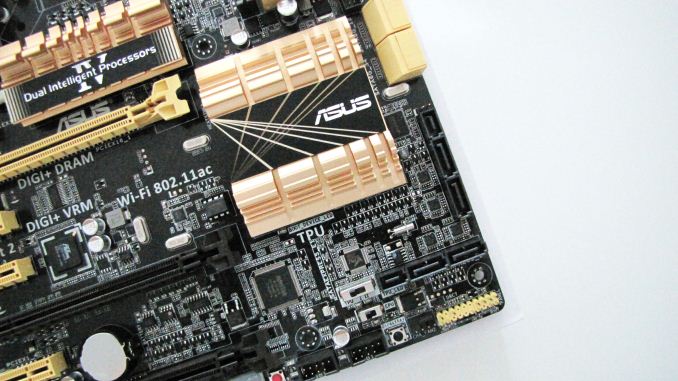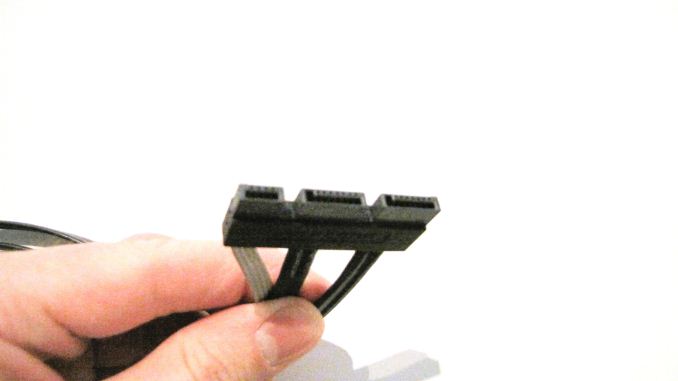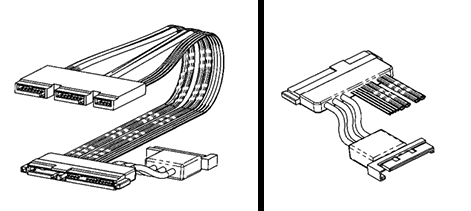Testing SATA Express And Why We Need Faster SSDs
by Kristian Vättö on March 13, 2014 7:00 AM EST- Posted in
- Storage
- SSDs
- Asus
- SATA
- SATA Express
What Is SATA Express?
Officially SATA Express (SATAe from now on) is part of the SATA 3.2 standard. It's not a new command or signaling protocol but merely a specification for a connector that combines both traditional SATA and PCIe signals into one simple connector. As a result SATAe is fully compatible with all existing SATA drives and cables and the only real difference is that the same connector (although not the same SATA cable) can be used with PCIe SSDs.
As SATAe is just a different connector for PCIe, it supports both the PCIe 2.0 and 3.0 standards. I believe most solutions will rely on PCH PCIe lanes for SATAe (like the ASUS board we have), so until Intel upgrades the PCH PCIe to 3.0, SATAe will be limited to ~780MB/s. It's of course possible for motherboard OEMs to route the PCIe for SATAe from the CPU, enabling 3.0 speeds and up to ~1560MB/s of bandwidth, but obviously the PCIe interface of the SSD needs to be 3.0 as well. The SandForce, Marvell, and Samsung designs are all 2.0 but at least OCZ is working on a 3.0 controller that is scheduled for next year.
The board ASUS sent us has two SATAe ports as you can see in the image above. This is a similar port that you should find in a final product once SATAe starts shipping. Notice that the motherboard connector is basically just two SATA ports and a small additional connector—the SATA ports work normally when using a standard SATA cable. It's only when the connector meets the special SATAe cable that PCIe magic starts happening.
ASUS mentioned that the cable is not a final design and may change before retail availability. I suspect we'll see one larger cable instead of three separate ones for esthetic and cable management reasons. As there are no SATAe drives available yet, our cable has the same connector on both ends and the connection to a PCIe drive is provided with the help of a separate SATAe daughterboard. In the final design the other end of the cable will be similar to the current SATA layout (data+power), so it will plug straight into a drive.
That looks like the female part to the SATA connector in your SSD, doesn't it?
Unlike regular PCIe, SATAe does not provide power. This was a surprise for me because I expected SATAe to fully comply with the PCIe spec, which provides up to 25W for x2 and x4 devices. I'm guessing the cable assembly would have become too expensive with the inclusion of power and not all SATA-IO members are happy even with the current SATAe pricing (about $1 in bulk per cable compared to $0.30 for normal SATA cables). As a result, SATAe drives will still source their power straight from the power supply. The SATAe connector is already quite large (about the same size as SATA data + power), so instead of a separate power connector we'll likely see something that looks like this:
In other words, the SATAe cable has a power input, which can be either 15-pin SATA or molex depending on the vendor. The above is just SATA-IO's example/suggestion—they haven't actually made any standard for the power implementation and hence we may see some creative workarounds from OEMs.















131 Comments
View All Comments
frenchy_2001 - Friday, March 14, 2014 - link
no, it does not. It adds latency, which is the delay before any command is received. Speed stays the same and unless your transmission depends on hand shake and verification and can block, latency is irrelevant.See internet as a great example. Satellite gives you fast bandwidth (it can send a lot of data at a time), but awful latency (it takes seconds to send the data).
As one point of those new technology is to add a lot of queuing, latency becomes irrelevant, as there is always some data to send...
nutjob2 - Saturday, March 15, 2014 - link
You're entirely incorrect. Speed is a combination of both latency and bandwidth and both are important, depending on how the data is being used.Your dismissal of latency because "there is always data to send" is delusional. That's just saying that if you're maxing out the bandwidth of your link then latency doesn't matter. Obviously. But in the real world disk requests are small and intermittent and not large enough to fill the link, unless you're running something like a database server doing batch processing. As the link speed gets faster (exactly what we're talking about here) and typical data request sizes stay roughly the same then latency becomes a larger part of the time it takes to process a request.
Perceived and actual performance on most computers are very sensitive to disk latency since the disk link is the slowest link in the processing chain.
MrPoletski - Thursday, March 13, 2014 - link
wait:by Kristian Vättö on March 13, 2014 7:00 AM EST
It's currently March 13, 2014 6:38 AM EST - You got a time machine over at Anandtech?
Ian Cutress - Thursday, March 13, 2014 - link
I think the webpage is in EDT now, but still says EST.Bobs_Your_Uncle - Saturday, March 15, 2014 - link
PRECISELY the point of Kristian's post. It's NOT a time machine in play, but rather the dramatic effects of reduced latency. (The other thing that happens is the battery in your laptop actually GAINS charge in such instances.)mwarner1 - Thursday, March 13, 2014 - link
The cable design, and especially its lack of power transmission, is even more short sighted & hideous than that of the Micro-B USB3.0 cable.3DoubleD - Thursday, March 13, 2014 - link
Agreed, what a terrible design. Not only is this cable a monster, but I can already foresee the slow and painful rollout of PCIe2.0 SATAe when we should be skipping directly to PCIe3.0 at this point.Also, the reasons given for needing faster SATA SSDs are sorely lacking. Why do we need this hideous connector when we already have PCIe SSDs? Plenty of laptop vendors are having no issue with this SATA bottleneck. I also debate whether a faster, more power hungry interface is actually better on battery life. The SSD doesn't always run at full speed when being accessed, so the battery life saved will be less than the 10 min calculated in the example... if not worse that the reference SATA3 case! And the very small number of people who edit 4k videos can get PCIe SSDs already.
DanNeely - Thursday, March 13, 2014 - link
Blame Intel and AMD for only putting pcie 2.0 on the southbridge chips that everything not called a GPU are connected to in consumer/enthusiast systems.Kristian Vättö - Thursday, March 13, 2014 - link
A faster SSD does not mean higher power consumption. The current designs could easily go above 550MB/s if SATA 6Gbps wasn't bottlenecking, so a higher power controller is not necessary in order to increase performance.fokka - Thursday, March 13, 2014 - link
i think what he meant is that while the actual workload may be processed faster and an idle state is reached sooner on a faster interface, the faster interface itself uses more power than sata 6g. so the question now is in what region the savings of the faster ssd are and in what region the additional power consumption of the faster interface.